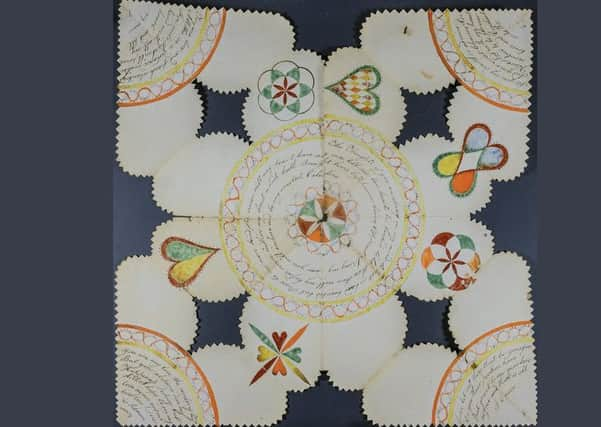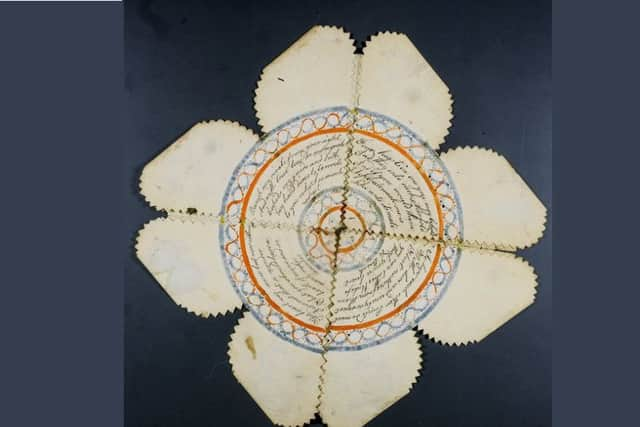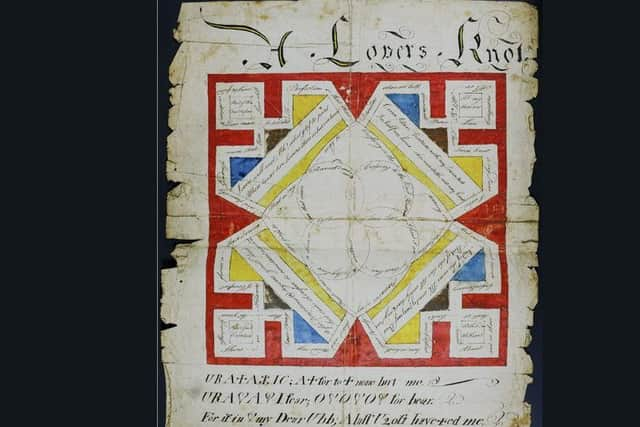Exhibit of the Week: Valentine's Day cards


And we’re fairly rank amateurs compared to the Americans, who are estimated to have handed over a whopping $19.7bn last year.
Oh for the days when a gesture of love came from the heart, not the pocket. Take these two Valentines from the Scarborough Collections, for instance. Handmade and believed to date from the early to mid Victorian period, their creators were lavish with their time and attention to detail. The knot garden Valentine is simple but striking with a rather medieval, heraldic feel, and a verse at the bottom that seems to foreshadow today’s text speak with its heart symbols and use of ‘UR’ to represent ‘you are’.
Advertisement
Hide AdAdvertisement
Hide AdThe second, more elaborate, Valentine, is incredibly detailed, with pinked hearts that fold into a version of the origami paper fortune tellers we used to make at school; although it seems the sender wasn’t having much fortune with the object of his or her affections, penning a series of plaintive verses including:


“You are my love, the center [sic] of my joy
But your abstane [absence?] does my Happiness Destroy
But still I hope to see my love again
And in true love forever to Remain.”


We can but hope that it all worked out in the end.
The earliest Valentine’s Days were celebrated by the Romans, who held Lupercalia, a festival of spring and fertility, between 13 and 15 February: in distinctly unromantic fashion, the men would sacrifice a goat then use its skin to whip women in the belief that it would make them fertile. It’s believed that, in the 5th century AD, the festival was Christianised and named after one of two possible Roman St Valentines.
Chaucer mentions ‘Volantynys day’ in his poem Parlement of Foules in 1382, and a century later, the French (and perhaps this contributes to their reputation as a nation of great lovers) were holding annual feast days celebrating romantic love on 14 February.
The 15th-century Duke of Orleans sent the first known written Valentine to his wife from the Tower of London where he was imprisoned after the Battle of Agincourt in 1415:


“Je suis desja d’amour tanné
Ma tres doulce Valentinée”
Advertisement
Hide AdAdvertisement
Hide AdSome 190 years later, Shakespeare has poor doomed Ophelia in Hamlet declare:
“To-morrow is Saint Valentine’s day,


All in the morning betime,
And I a maid at your window,
To be your Valentine.”
Until the late 18th century Valentine’s Day was a low-key event, but the increasingly sophisticated printing techniques that came about as the result of the Industrial Revolution gave a huge boost to the greetings card industry: it’s estimated that by the mid 1820s, around 200,000 Valentines were sent in London alone – a huge amount, given that the city’s population was only in the region of one-and-a-half million at the time.
A lesser known offshoot of the Valentine’s industry that blossomed in the 19th century were the so-called ‘vinegar’ or ‘mock’ Valentines which, with typically Victorian ‘humour’ mocked the recipient’s looks, intelligence or personality, often quite cruelly – we’re pleased to report that these originated in America, although it seems we were quick enough to adopt them on our side of the pond. Adding injury to insult, we should remember that until the 1840s it was the recipient, not the sender, who was responsible for the postage!
The two Valentine’s Day cards are part of the Scarborough Collections, the name given to all the museum objects and artwork acquired by the borough over the years, and now in the care of Scarborough Museums Trust. For further information, please contact Collections Manager Jennifer Dunne on [email protected] or 01723 384510.